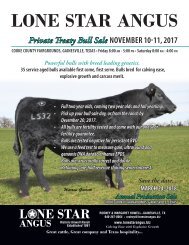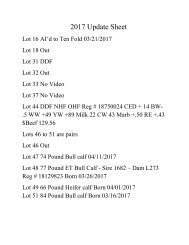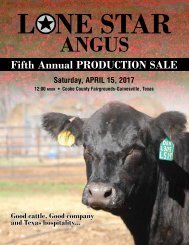Create successful ePaper yourself
Turn your PDF publications into a flip-book with our unique Google optimized e-Paper software.
Sale Information<br />
SCHEDULE OF EVENTS<br />
FRIDAY, MARCH 23<br />
All day Cattle available for viewing at the sale facility<br />
SATURDAY, MARCH 24<br />
All day Cattle available for viewing at the sale facility<br />
11:30 am Complimentary lunch served at the sale facility<br />
1:00 pm LONE STAR ANGUS PRODUCTION SALE<br />
SALE ORDER<br />
Cattle will sell in sale book order.<br />
SEMEN INTEREST<br />
Lone Star Angus is retaining one-half, revenue sharing, semen interest<br />
in all bulls selling, unless otherwise noted.<br />
FREE DELIVERY<br />
Free delivery with a $10,000 purchase of registered cattle within<br />
200 miles.<br />
BREEDING SOUNDNESS GUARANTEE<br />
Lone Star guarantees the fertility of our bulls for one year from the<br />
date of purchase. If a healthy bull fails two fertility exams, a credit for<br />
the purchase price minus salvage value will be available at our next<br />
sale.<br />
COMMERCIAL CATTLE<br />
Each lot of commercial cattle will have a representative group of five<br />
head at the sale facility. The balance of the consignment will be picked<br />
up at the ranches. We will help the buyers arrange for trucking.<br />
ABOUT THE BULLS<br />
All bulls were born in the fall of 2016 and are ready for heavy service.<br />
Bulls can be picked up at the sale or from the ranch by May 15.<br />
STAR RATINGS<br />
Lone Star Angus has provided a star rating system in this year’s book<br />
for assistance with your bull buying decisions.<br />
CALVING EASE:<br />
Our star system for calving ease is designed to make purchasing bulls<br />
for first calf heifers and mature cows easier. I evaluated the EPDS:<br />
CED and BW, the pedigrees, actual birth weights and the physical<br />
appearance of the bulls to arrive at a rating.<br />
Calves from 5 Star bulls should be very small and given normal delivery,<br />
there is not much chance of problems.<br />
4 Star calving ease bulls are what we are trying to raise. These bulls<br />
will work great on first calf heifers and mature cows. We have avoided<br />
for generations rough boned AI sire and used sires that have nice<br />
little Angus heads. The shape of the calf is almost as important as the<br />
weight.<br />
3 Star calving ease bulls could be used on large or crossbred first<br />
calf heifers but should be monitored closely.<br />
2 Star calving ease bulls will work great on mature cows. I have<br />
never had a customer with a calving problem on mature cows. There<br />
is some correlation between higher birth weights and higher weaning<br />
weights.<br />
1 Star Bulls. We do not raise bulls that cause calving difficulty in<br />
grown cows.<br />
AMERICAN ANGUS ASSOCIATION GENOMIC ENHANCED EPDS<br />
Courtesy of the American Angus Association<br />
Genomic results are a way to enhance predictability of current selection tools, to achieve more accuracy on EPDs for younger animals, and to characterize<br />
genetics for traits where it’s difficult to measure the animal’s own performance for the trait, such as carcass traits in breeding stock or maternal traits<br />
in bulls. With the investment in genomic technology, this means that in addition to the pedigree, performance and progeny information that are used in<br />
the calculation and reporting of Angus EPDs, genomic test results have also been incorporated into the EPD.<br />
Genomic-enhanced EPDs (GE-EPDs) are important because they make use of the results from the genomic, or DNA, test in addition to all other sources<br />
of information to provide added accuracy and reliability to the animal’s EPD. In fact, depending on the trait, GE-EPDs on unproven animals have the<br />
same amount of accuracy as if they had already sired 8-20 calves.<br />
In the American Angus Association genetic evaluations, the genomic results are incorporated into the EPDs as a correlated trait. Through AGI research<br />
and development, a genetic relationship is calculated between the values obtained from the genomic test results and the phenotypic data at the Association.<br />
Typically there are two measures used to report the relationship of a genomic test and phenotype, the genetic correlation and percent of additive<br />
genetic variance accounted for by the test. These two measures are related, and if one is known, the other can be calculated. The genetic correlation is<br />
the square root of the percent additive genetic variance and, conversely, the percent additive genetic variance is the squared value of the genetic correlation.<br />
For example, if the genetic correlation between the genomic result and the phenotypic measure is .60, then the genomic result explains 36% of the<br />
additive genetic variance for that particular trait. Simply stated, the more genetic variance a test explains, the more impact it will have on your EPDs and<br />
accuracies for that trait. Across all traits, the genetic correlations that have been estimated between the high density genomic tests purchased through<br />
AGI and the American Angus Association’s phenotypic database effectively ranged from .60 to .70, except for milk and heifer pregnancy.<br />
Genomic results are used as indicator traits in the evaluations to compute EPDs. Genomics do not completely describe the variation in the traits of<br />
interest. Breeders sometimes ask if it is no longer necessary to collect weights and measures (e.g., weaning weights, scan data, carcass measures). On<br />
the contrary, phenotypic measures collected by Angus breeders continue to be an important part in further development of improved genomic panels<br />
and the refinement of this technology over time, not to mention an important component in EPD calculation.<br />
Genomic results are a way to enhance the current selection tools, to achieve more accuracy on predictions for younger animals, and to characterize genetics<br />
for traits where it’s difficult to measure the phenotype. To learn more about available genomic tests, go to http://www.angus.org/AGI/default.aspx.<br />
Save the Date - Fall Private Treaty Bull Sale November 9-10, 2018<br />
Page 2





